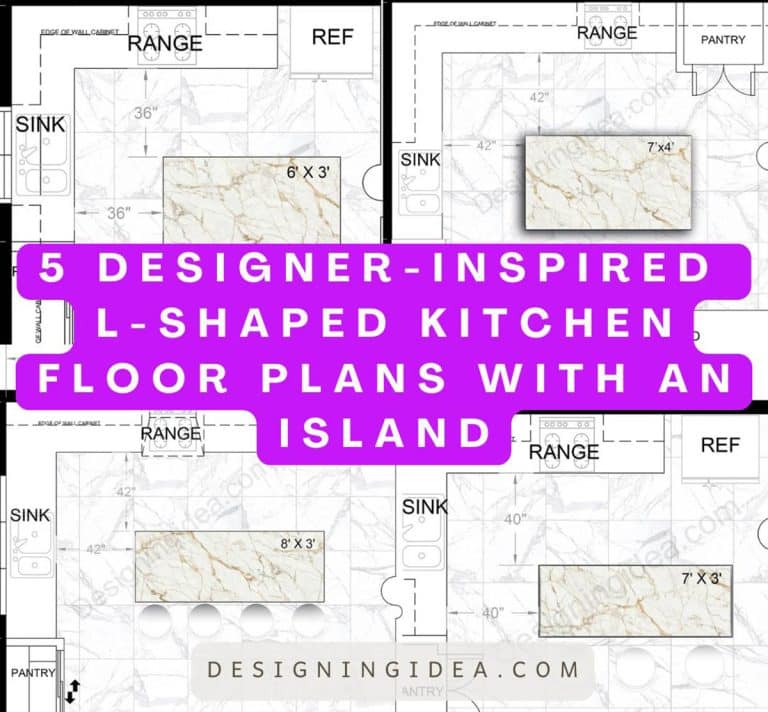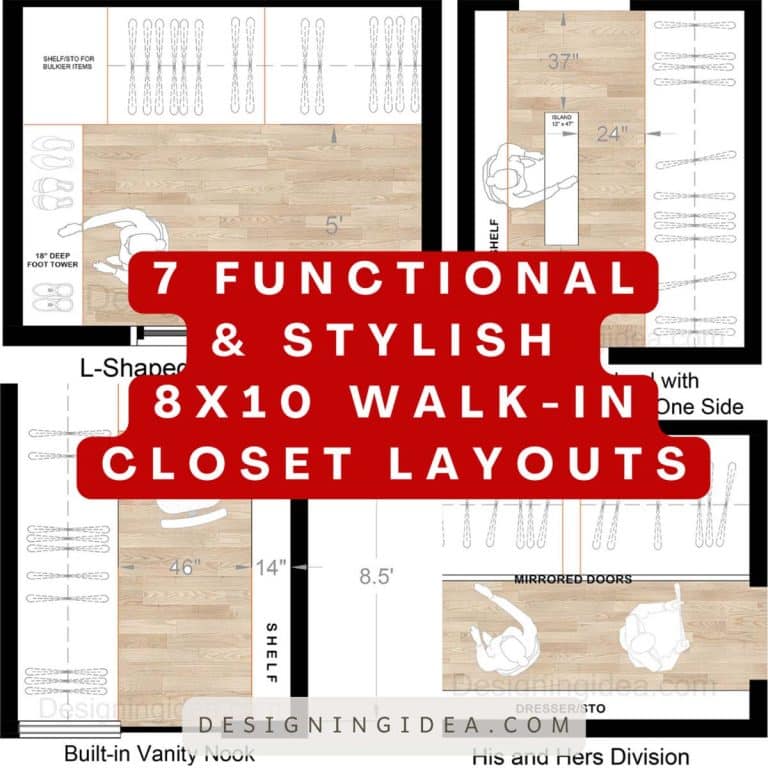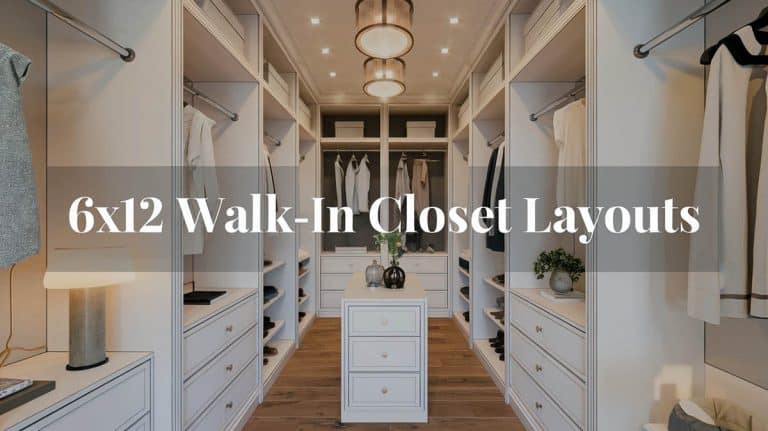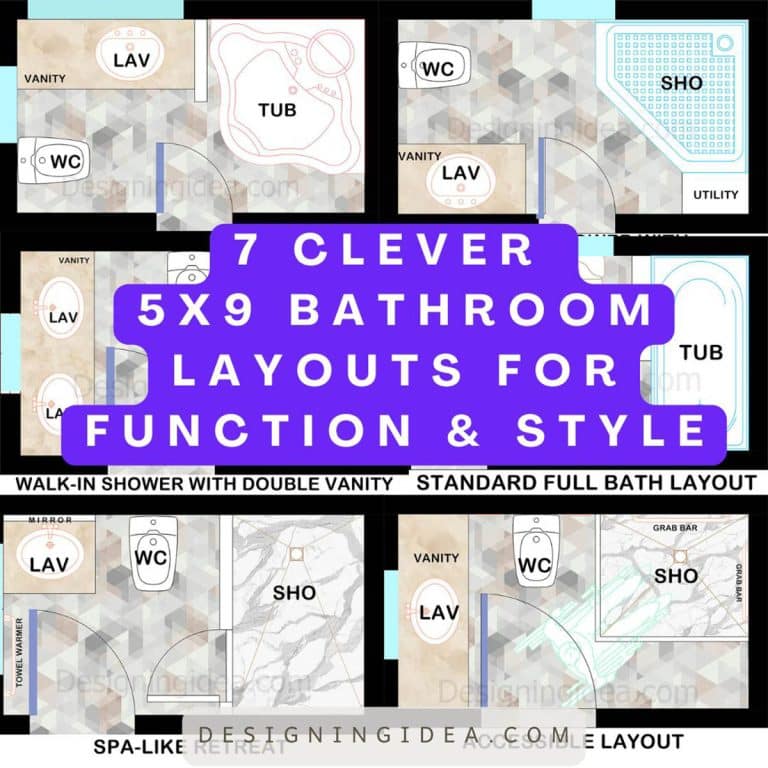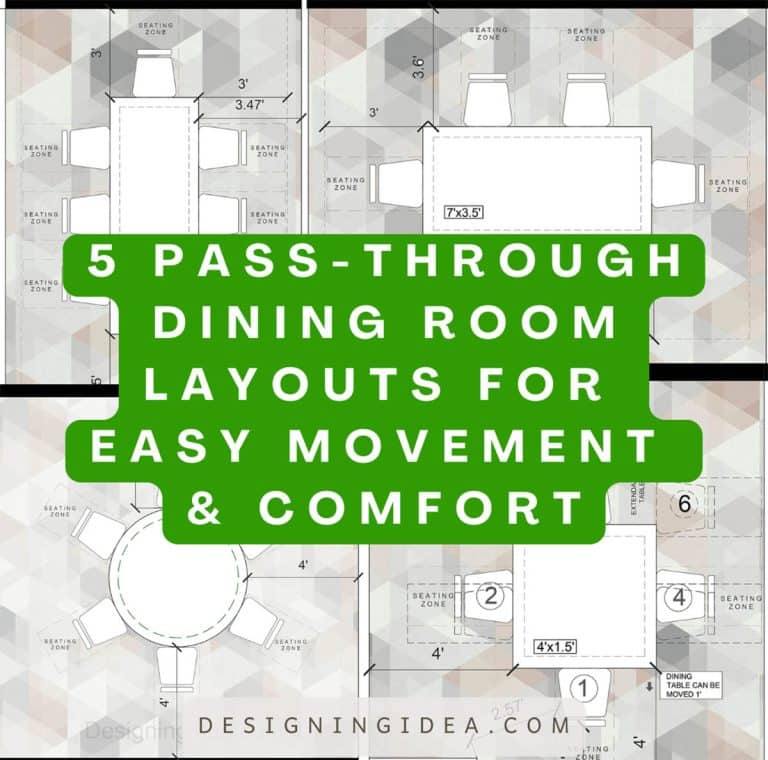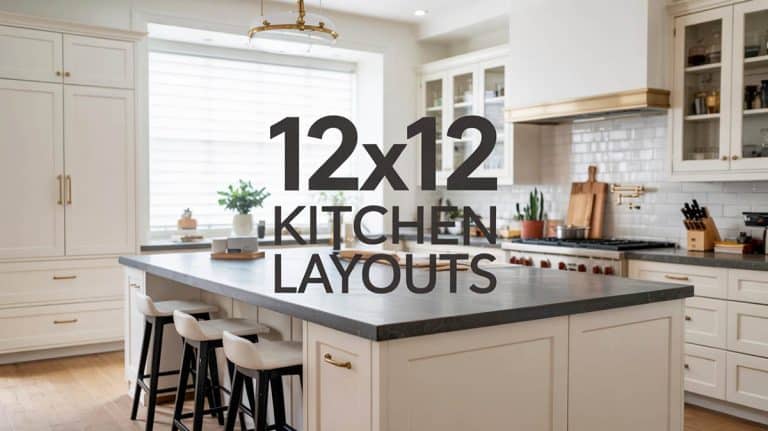6×6 Walk-In Closet Layout Ideas To Maximize Storage And Floor Space
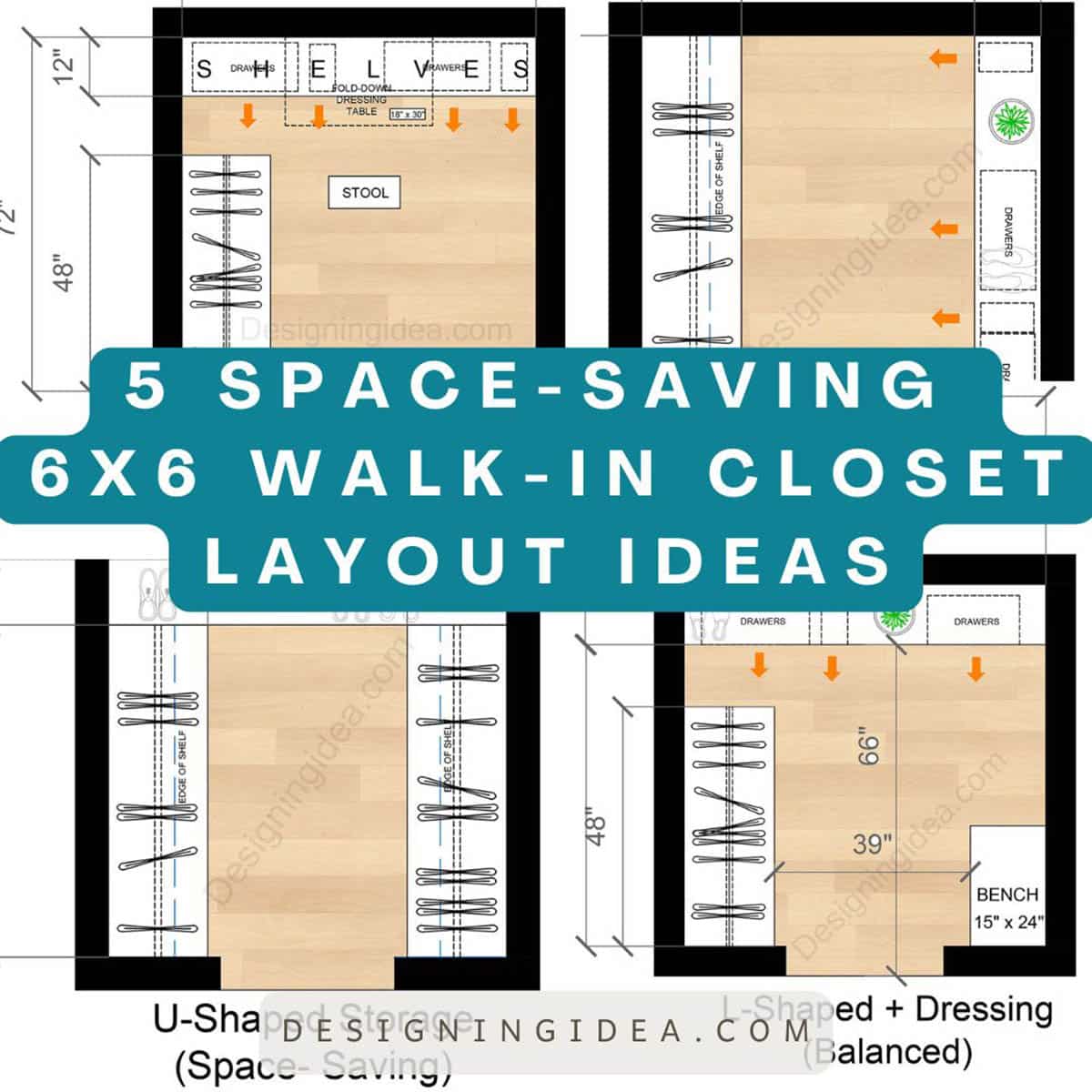
Dreaming of a walk-in closet but only have a six-foot square to spare? Don’t let the tight footprint fool you, a 6 × 6 closet can punch far above its size when the layout is dialed in. From space-saving U-shapes and balanced L-runs to boutique-style galleries, the right plan turns 36 square feet into a high-function dressing zone with room for hanging garments, drawers, shoes, and even a vanity perch. In the ideas that follow, you’ll see proven configurations, with each complete with key dimensions and designer tricks to help you squeeze every stylish inch out of your small but mighty walk-in.
U-Shaped Storage Closet Layout (Space-Saving)
A space-saving u-shape allows a lot of versatility, with a generous walking aisle for a design-savvy, symmetrical feel.
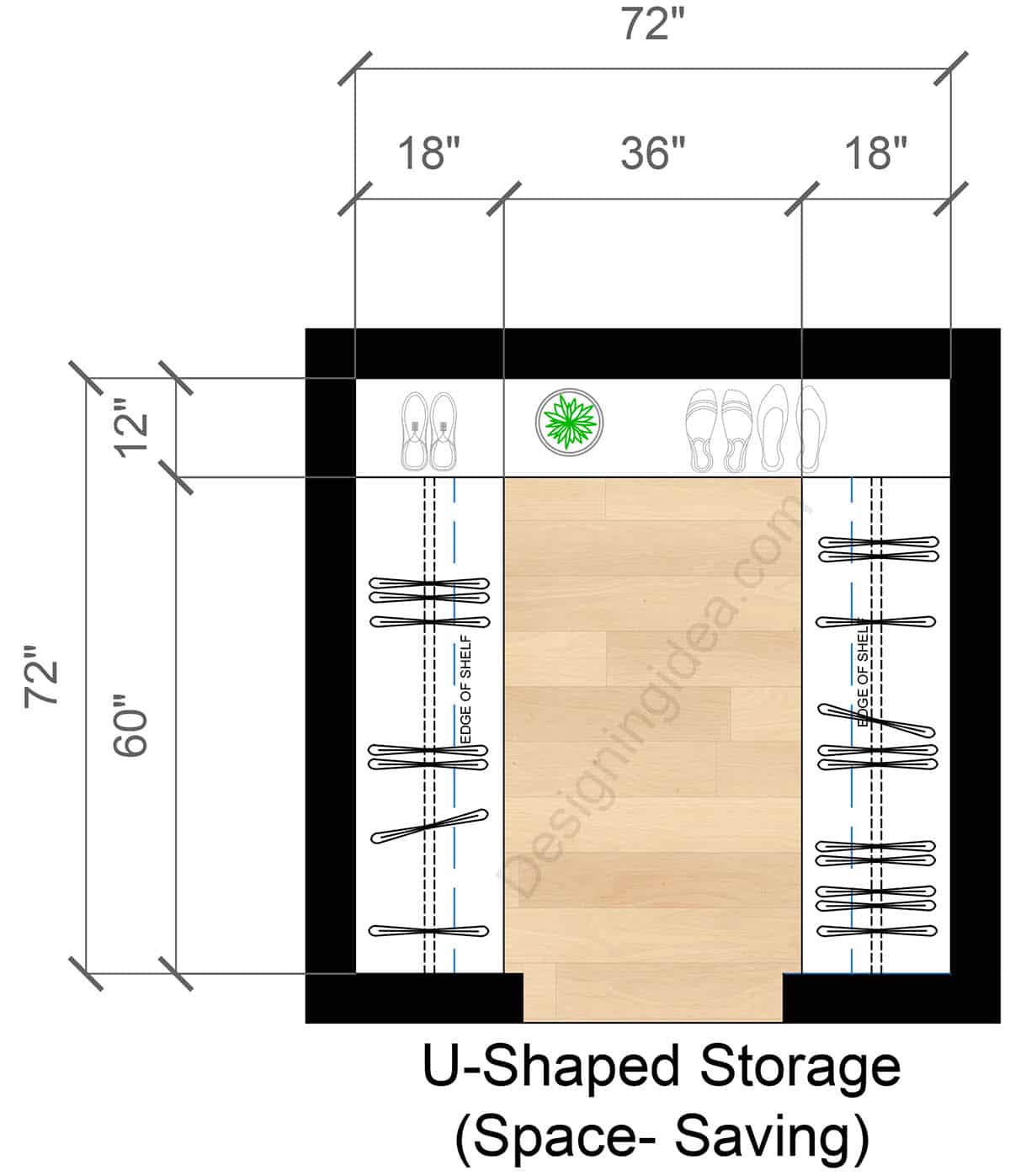
Floor Plan Details: The U-shaped closet is fitted with 12-inch-deep shelving on all three sides to create the familiar “U.” The whole back wall carries a continuous 72-inch run of shelves. At the same time, the left and right returns extend 60 inches each but stop a foot shy of the doorway so the casing and door swing remain unobstructed. That decision protects a 36-inch-wide by 60-inch-deep central aisle, which is ample turning space for one person and even workable for a wheelchair when the door opens outward. Inside the doorway on the entry wall, there’s just enough floor area for a slim bench or hamper.
Design Tips:
- Convert one side to hanging if you need it. Install an under-shelf valet rod or a perpendicular pull-out rod on the first 24–30″ of either side. You’ll fit a week’s worth of shirts without sacrificing the shallow footprint elsewhere.
- Use adjustable standards. The dotted blue line marks ideal placement for wall-mounted standards; they let you swap from shoe racks to cubbies for sweaters or blouses as seasons change.
- Light from the top down. Run an LED tape under the 72″ back shelf and along both side runs. Because the shelves are only 12″ deep, one strip per wall will wash the entire cavity with shadow-free light.
- Centerpiece styling. The 36″ stretch of back shelf directly opposite the door is prime real estate for a small mirror, valet tray, or décor accent (the green plant shown). It draws the eye in and makes the closet feel intentional rather than purely utilitarian.
- Add a slim landing spot. A 16 to 18″-wide flip-top bench just inside the door doubles as a seat for putting on shoes and hidden storage for out-of-season scarves or belts.
- Finish choices. For a plan this size, go for pale wood or melamine shelves (echoing the light plank floor in the plan), keep the compact space bright; matte-black brackets replicate the plan’s graphic lines and tie in with door hardware.
L-Shaped Closet With Dressing Bench Design (Balanced)
The L-shape and the generous dressing area with a bench is perfect for getting ready for work or a night out.
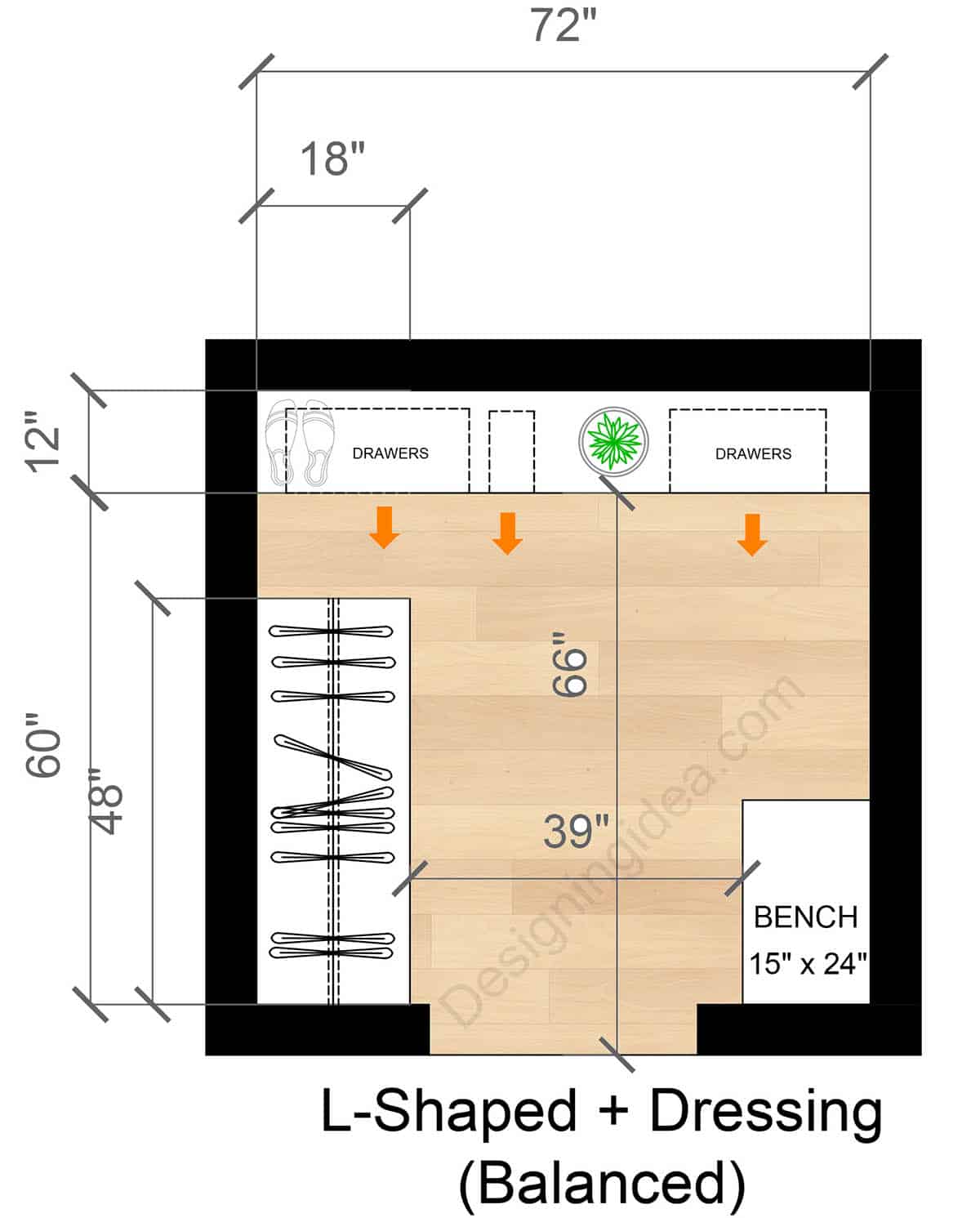
Floor Plan Details: The closet organizes its clothing storage in an L-shape orientation that wraps the entire back wall, plus the first 60 inches of the left side. Along the back section, cabinetry is a full 18 inches deep, deep enough to accept drawer modules, stacked clothes, and boxes or bins. The side run is purposefully kept slimmer at 12 inches deep, creating five tiers of shoe or handbag shelving. There’s a clear, rectangular “dressing zone” that gives room to move and try on outfits in front of a large mirror. A built-in bench, measuring 15 × 24 inches, sits on the opposite front corner; it occupies space the square footprint would otherwise waste while giving you a perch for putting on shoes or heels and staging tomorrow’s outfit. Together, the back and side runs provide roughly 12 linear feet of storage, yet the centre aisle still feels roomy thanks to its nearly 40-inch width, and gives ample room to pivot or set down a laundry basket.
Design tips:
- Layer storage depths for efficiency. Use the 18-inch back wall for full-depth drawers or deep cubbies, reserving the 12-inch side shelves for shoes and folded shirts. This split maximises capacity without crowding the walkway.
- Keep the entry crisp. By pulling shelving a foot back from the doorway, you eliminate door-swing conflicts and gain visual breathing space.
- Light the work zone. Give it some glam by installing an LED strip beneath the 18-inch top shelf; the light will wash down the back run and double as task lighting to help see items.
- Exploit the bench niche. Finish the 15 × 24-inch seat with a lift-up lid for hidden hamper storage, or upholster it in a wipe-clean performance fabric, so it can serve as a suitcase stand during packing.
- Balance the view. Flank the central open span of the back shelf with matching drawer towers (as shown by the dotted lines). The symmetry reads “boutique” rather than “utility closet,” and will give the space a more luxury feel.
Galley-Style Closet Floor Plan (Most Efficient)
The galley-aisle style is ideal for visibility and reach, as everything is visible and not hidden around any corners with room for a large mirror or bench in back.

Floor Plan Details: The galley style works well as a single continuous run on each long wall offers an unobstructed center aisle. The left-hand wall carries the “workhorse” section with its 18-inch-deep bank of open shelving (or a single-rod + shelf combination). Directly opposite, the right-hand wall is fitted with a slimmer, 12-inch-deep tower of drawers and cubbies. Those staggered depths give a generous 42-inch clear aisle from shelf edge to drawer face and is wide enough for two people to pass without pinching off circulation. A standard 30 to 32″ door is centered on the entry wall, and because both storage runs terminate flush with the back wall, there’s no need to notch shelving around the door casing. In total you gain roughly 15 linear feet of accessible storage while keeping every square inch of floor space in the middle free for dressing. The 42″ aisle exceeds the 36″ minimum that most closet designers target, and allows the small room to feel airy and allows doors or drawers on the right side to open without clipping your heels.
Design Tips:
- Put depth where it counts. Mount a 1-rod/1-shelf combo on the 18-inch wall for hanging shirts and jackets, then slide slim, full-extension drawers or wire baskets into the 12-inch tower on the other side.
- Use the aisle wall for vertical helpers. Because the centre aisle is clear, the back of the door (or the wall it swings against) is prime real estate for shallow accessories: a belt rack, valet hook or mirror, no thicker than 2 inches.
- Light from each side, not just overhead. An overhead fixture alone will cast shadows onto the shelving. Run low-profile LED tape beneath shelves so the cross-lighting washes both storage planes evenly and makes colours more accurate when matching outfits.
- Go uniform at eye level. Keep the first 48 to 54 inches of vertical space consistent by using either all hanging or all drawers, so your sightline is clean the moment you step in. Stash visual clutter (shoe boxes, off-season clothes) on the top shelf where it’s above eye level.
- Upgrade drawer front hardware. Swap plain drawer faces for shiplap-style panels or matte-brass finger pulls. Because a galley closet presents two uninterrupted walls, even small hardware upgrades can give the design a more polished look.
- Portable seat instead of a fixed bench. A flip-up stool or a rolling ottoman (18 in. cube) can live under the hanging section and pull out only when you need a seat or a place to rest a laundry basket, and is perfect for preserving the galley’s straight-shot circulation.
Single-Wall Closet With Vanity Layout (Open Feel)
For an open-boutique feel with a vanity area for makeup or grooming, this design feels open and airy, considering its smaller 6ft by 6ft size.

Floor Plan Details: The single wall closet with vanity has every storage element concentrated on the back wall, leaving the remaining three sides completely open for dressing. A full-length combination shelf and hanging rod spans the entire 72-inch width in back. It projects 20 inches from the wall and is deep enough for full-size hangers and jackets. This allows a generous 51-inch clear zone between the rod and the doorway. That open span is what makes the layout feel airy compared to denser U- or L-shapes, at the expense of storage. A compact vanity measuring 15″ deep × 36″ wide nestles into the front-right corner. The floor stays obstruction-free, giving you a full 5-foot turning circle for dressing or parking a small hamper.
Design Tips:
- Turn the vanity into a light source. Frame the mirror with vertical sconces as the side lighting helps eliminate shadows on your face and doubles as ambient illumination for there’s of the space.
- Add hidden shoe storage under the rod. A toe-kick drawer or shallow rollout trays under the hanging section keep the floor tidy without stealing any extra space.
- Use adjustable height for seasonality. Mount the rod on wall standards so you can lower it for longer dresses in summer and raise it to reclaim shoe space in the winter.
- Choose light and airy finishes. Because the layout relies on openness, stick to light-toned cabinets or white wire shelving and pair it with a pale vanity top made of marble, quartz, or white oak to bounce light around.
- Bring in a portable seat. A folding stool or low ottoman can live under the vanity and slide out only when you need a perch—ideal for maintaining the uncluttered centre floor.
- Add a mirrored closet door. Swapping the solid door for a full-length mirrored slab (or adding a mirror back-of-door) visually enlarges the 6-foot cube and provides a head-to-toe spot to check the outfit.
Corner Closet With Fold-Down Dressing Table
With its corner storage setup complete with a fold-down-dressing table you can preserve space and benefit from an uncluttered feel.
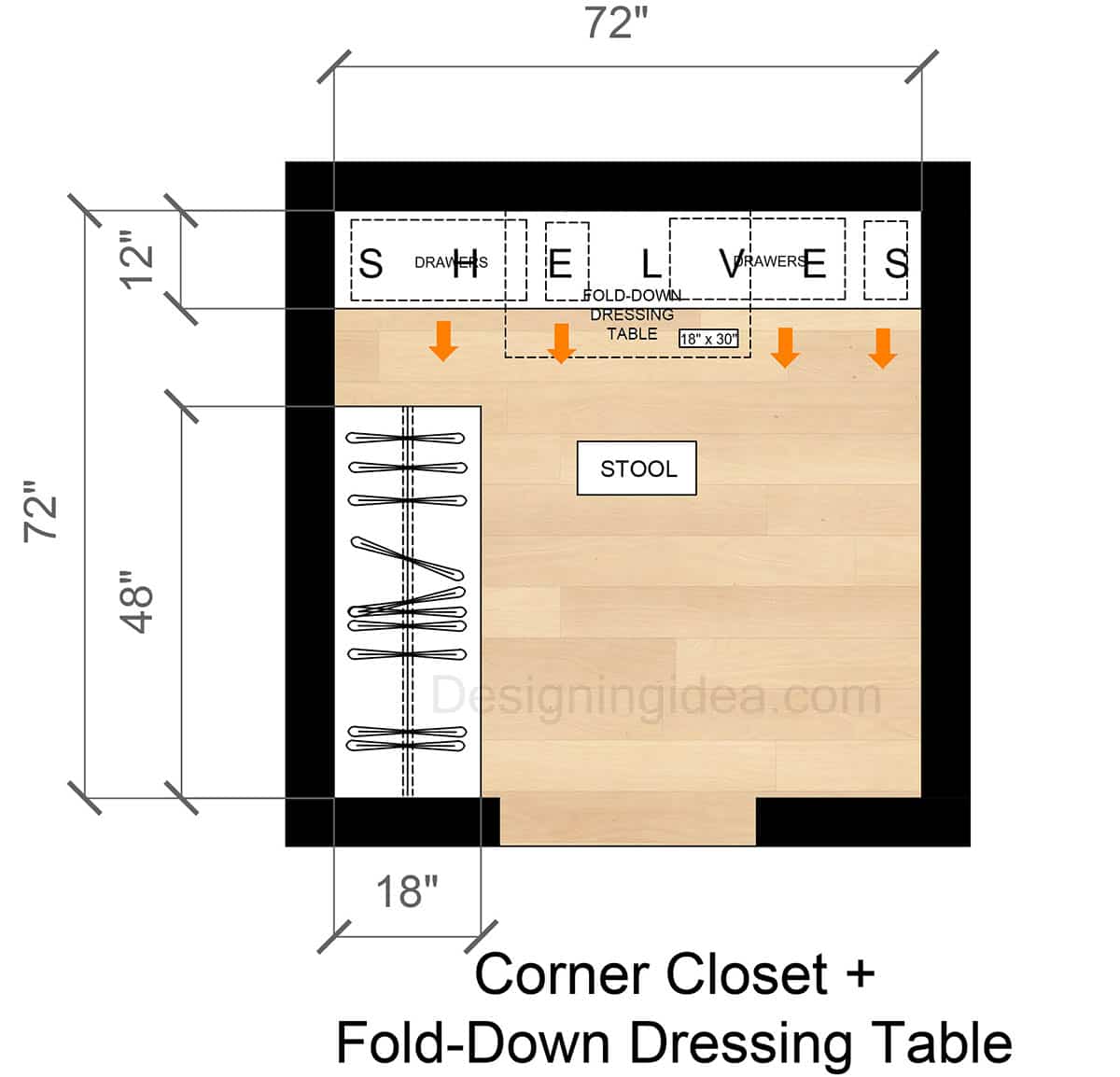
Floor Plan Details: This 6-by-6-foot corner closet design concentrates its storage in the back-left corner so the center stays open for dressing. For the back wall, a continuous, 12-inch-deep cabinet stretches the full 72 inches and is divided into shallow drawers at each end and open shelves in the middle. Concealed beneath the central shelf section is an 18″ × 30″ fold-down dressing table that hinges out when you need a surface and disappears flush against the wall when not required.
The left wall picks up the “L” with a deeper, 18-inch-deep storage tower that runs 48 inches up from the floor and about 18 inches out from the corner. This can be outfitted with a rod or angled shoe trays, and the tower is great for any bulky items and shoes that would crowd the shallower back wall. Once those two corner elements are in place, the plan leaves a clear floor zone roughly 54 inches wide by 60 inches deep, and offers enough space for a freestanding stool that can slide under the fold-down table.
Design Tips:
- Make the folding table a focal point. Finish the underside (the face you’ll see when the table is stowed) with a mirror or tufted fabric so it adds texture even when closed.
- Choose dual-purpose seating. A small cube stool with hidden storage keeps hair tools or travel accessories out of sight and rolls wherever you need it.
- Optimise the deep tower. Mount the rod high (66 to 68 inches) and slip two pull-out shoe drawers beneath to capture the full vertical span without widening the footprint.
- Keep the middle free. Since the success of this layout depends on an open floor, avoid fixed hampers. Instead, use a collapsible canvas basket that stores flat and can be moved where you want.
- Think about your seasonal swaps. Label the shallow drawer stacks “in-season” and “off-season.” Then, rotate your clothing twice a year to keep only the current items within arm’s reach and prevent overstuffing the limited cabinet space.
For more like this, visit our 5×5 walk-in closet floor plans on this page.

